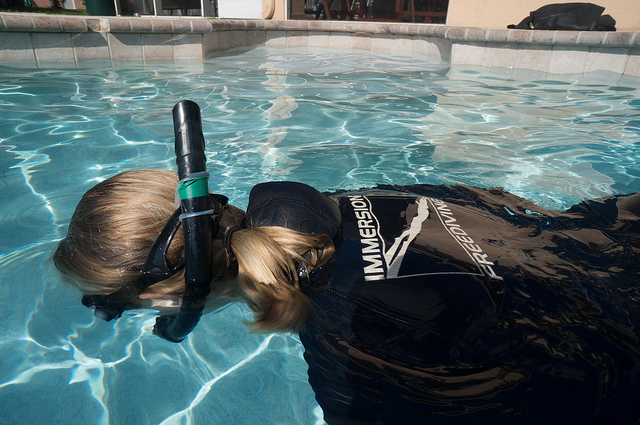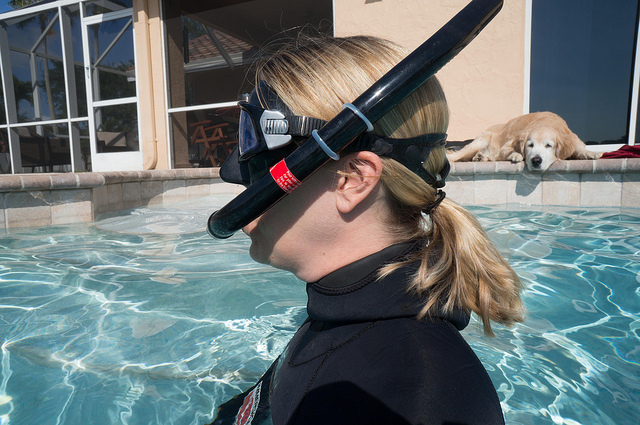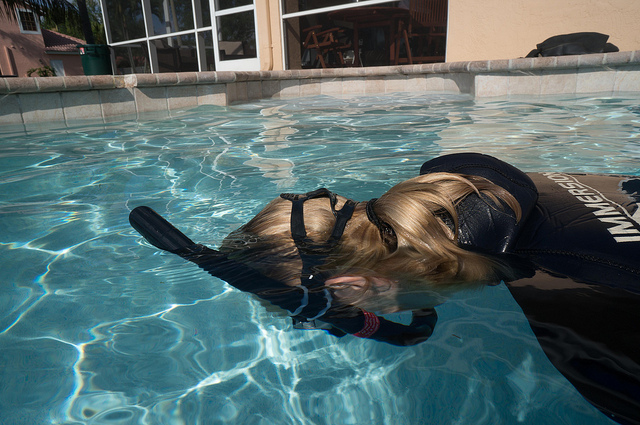Let’s face it. The snorkel is probably the most boring thing you have in your gear bag, so you’re probably wondering why I’d dedicate an entire article to this sad little piece of equipment. For one reason: when I showed this tip to Jeromy Gamble, owner of Spearing magazine, his jaw dropped. He couldn’t believe he never figured this out himself and that what I’m about to tell you isn’t common knowledge. Well, let’s end the suspense.
Top Snorkel Tips
Most all freedivers, scuba divers and even scuba instructors set their snorkel up the same way. In scuba, the regulator is on the right, so you place the snorkel on the left, likely attached very close to the left side of the mask. The snorkel-keeper or attachment point is likely near the middle of the snorkel. Photo number 1 shows this typical set up. Setting it up this way causes the snorkel to be barely an inch above the water line when looking straight down in the water. Check out photo number 2.
The best snorkel keepers out there are the cheap, clear-rubber figure-8 ones, better than any of the fancy ones sold with most snorkels. Here’s what to do: Attach the snorkel keeper to the snorkel, but instead of attaching it in the middle of the snorkel, attach it much higher than you usually do, about to 1.5 to 2 inches from the top. Now attach the snorkel keeper in the back or center of the mask strap as opposed to the side of the mask strap. (See photo number 3). Using this method, the snorkel will be sitting on top of your head when you are face down. This lifts the snorkel an inch or two higher out of the water than the traditional method. See photo number 4.
This slight change in setup will absolutely reduce the amount of water you get in your snorkel, which will benefit any diver, regardless of experience. This setup also keeps the snorkel more streamlined when you’re not using it underwater. When scuba divers and freedivers have the snorkel set incorrectly, as in photo number 1, it twists back and forth when you’re underwater because it’s attached to the mask in the middle of the snorkel. If configured like the one in photo number 3, the snorkel will sit straight up and down when you’re not using it. Although it may not sound groundbreaking, if you dive with a snorkel, we promise: this will change your life.

We’ve also got an important piece of safety advice regarding the snorkel. Most freedivers go underwater with their snorkel in their mouth. When you do this, the water doesn’t rush into your mouth because your tongue is actively blocking the hole in the snorkel. If you were to black out underwater, your tongue would no longer actively block this hole — it would go limp like everything else. So water would rush into your mouth and possibly into your lungs. Diving underwater with the snorkel in your mouth violates the No. 1 rule of freediving safety — to always protect the airway.
Here are three simple suggestions to increase your safety while freediving:
- Dive one-up one-down; be close enough to grab your buddy when he or she surfaces.
- Watch your buddy for no less than 30 seconds every time he or she surfaces.
- Don’t free dive over-weighted. At the surface do a relaxed exhalation, like a sigh.
If you sink, you’re wearing too much weight. Keep taking off weight one pound at a time until you can pass this test.
Ted Harty teaches two or three PFI freediving classes every month in Fort Lauderdale, Florida via his company Immersion Freediving. You can see his course schedule at
immersionfreediving.com




